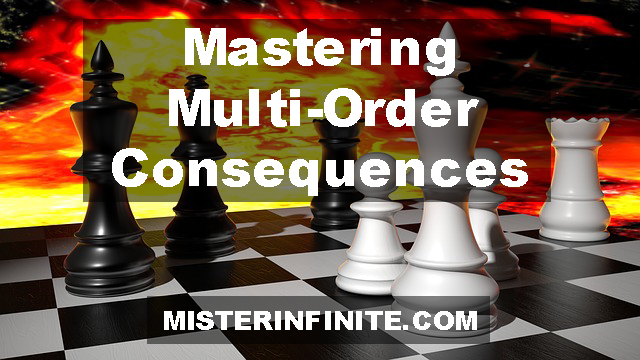In an increasingly complex and interconnected world, mastering multi-order consequences is a crucial skill for people and organizations alike.
First-order thinking involves immediate, direct effects, but second-order and third-order thinking delve into the ripple effects of decisions, anticipating not only the immediate outcomes but also the subsequent chain reactions.
Understanding and mastering these multi-order consequences can significantly enhance:
- Decision-making
- Strategic planning
- And long-term success.
The Concept of Multi-Order Consequences
To grasp the concept of multi-order consequences, it’s essential to understand the layers of impact a decision can have:
- First-order consequences are the immediate effects of an action. They are often straightforward and easily predictable.
- Second-order consequences are the subsequent effects that result from the first-order consequences. These can be less obvious and sometimes counterintuitive.
- Third-order and beyond consequences are the further ripples that propagate from the second-order effects. Each layer becomes progressively more complex and harder to predict.
The Importance of Multi-Order Thinking
Multi-order thinking is essential for several reasons:
1. Avoiding Unintended Consequences:
Many poor decisions stem from a failure to consider the second-order effects.
For instance, a company might cut costs by laying off employees to improve short-term profitability (first-order consequence), but this could lead to decreased morale and productivity among remaining employees (second-order consequence) and ultimately harm the company’s long-term performance (third-order consequence).
2. Enhancing Strategy:
Effective strategy requires an understanding of how actions will play out over time.
By anticipating multi-order consequences, leaders can develop more robust strategies that account for potential pitfalls and opportunities.
3. Sustainability and Long-Term Success:
Sustainable success depends on long-term thinking.
By considering the cascading effects of decisions, organizations can avoid strategies that offer immediate gains but lead to long-term detriment.
Examples of Multi-Order Consequences
Product Launches:
When a company introduces a new product, the immediate goal might be to capture market share (first-order consequence).
If the product is successful, it can lead to increased sales and revenue (second-order consequence).
However, if the company fails to anticipate the need for enhanced customer support and supply chain adjustments, it could face logistical challenges and customer dissatisfaction (third-order consequence).
Pricing Strategies:
A business might decide to lower prices to attract more customers and increase market penetration (first-order consequence).
This strategy could lead to higher revenue (second-order consequence).
However, the reduced margins might strain the company’s financial health, affecting its ability to invest in innovation and quality improvements (third-order consequence).
Strategies for Mastering Multi-Order Thinking
Mastering multi-order thinking involves developing several key skills and adopting specific strategies:
1. Systems Thinking:
By viewing decisions within the context of the larger system, people can better anticipate multi-order consequences.
For example, a business leader might consider how changes in one department could affect others, leading to a more holistic decision-making process.
2. First Principles Thinking:
First principles thinking involves breaking down complex problems into their most basic, foundational elements and then building up from there.
By understanding the fundamental truths underlying a situation, decision-makers can more accurately predict multi-order consequences and develop innovative solutions.
This method helps strip away assumptions and conventional wisdom, allowing for a clearer analysis of the cause-and-effect relationships that drive second- and third-order consequences.
For example, when considering the impact of a new technology, first principles thinking would encourage leaders to examine the core functionalities and potential disruptions at the most basic level, leading to a deeper understanding of the long-term implications.
3. Scenario Planning:

This technique involves creating detailed scenarios based on different potential futures using a “decision tree”.
By exploring various second- and third-order consequences of decisions, leaders can prepare for a range of possible outcomes and develop contingency plans.
4. Critical Thinking:
Developing critical thinking skills helps people question assumptions and consider alternative perspectives.
This can lead to a deeper understanding of potential consequences and better decision-making.
5. Feedback Loops:
Establishing feedback mechanisms allows for continuous learning and adjustment.
By monitoring the outcomes of decisions and their subsequent effects, organizations can refine their strategies and improve their ability to predict and manage multi-order consequences.
6. Collaboration With Other Perspectives:
Engaging with a trusted group can provide insights into potential consequences that might not be immediately apparent.
Different perspectives can help identify and mitigate risks associated with second- and third-order effects.
Progressive Mastery: A Lesson from Chess
The process of mastering multi-order thinking can be compared to learning chess.
Learning chess requires starting with the simplest concepts and progressively building up to more complex ones.
In chess, players are often advised to begin by mastering simple endgames – where there are fewer pieces on the board, allowing them to focus on foundational strategies.
Then, they move on to:
- More complex endgames
- Midgames
- And only later learn the openings.
By this stage, a player has a deeper understanding of how different elements of the game interact.
This gradual approach mirrors how mastering multi-order consequences works:
- Start with First-Order Consequences (Simple Endgames): Initially, focus on the most immediate effects of a decision – understanding the direct outcomes of your actions.
- Move to Second-Order Consequences (Complex Endgames): As your strategic thinking matures, begin to analyze the secondary effects of your decisions. Just as more pieces and positions in chess introduce complexity, real-life decisions often reveal hidden consequences that need to be anticipated.
- Master Third-Order Consequences (Midgames and Openings): Eventually, you will be able to consider multiple layers of consequences, understanding how short-term actions can ripple through to long-term impacts. In chess, this is akin to mastering the midgame and opening strategies, where foresight and preparation for future moves are essential for success.
This approach highlights the importance of building strategic thinking in stages.
By mastering simpler scenarios first, you develop a strong foundation / position to handle the complexity of second- and third-order consequences, much like how an advanced chess player navigates the nuances of the game.
Challenges and Pitfalls
Despite its importance, mastering multi-order consequences comes with challenges:
- Complexity and Uncertainty: Predicting second- and third-order consequences can be daunting due to the complexity and uncertainty involved. The further out the consequences, the harder they are to predict accurately.
- Cognitive Biases: Human cognitive biases, such as the tendency to favor immediate rewards over long-term gains, can hinder multi-order thinking. Overcoming these biases requires conscious effort and self-awareness.
- Resource Constraints: Thoroughly analyzing multi-order consequences requires time and resources, which may be limited in fast-paced environments. Balancing the need for thorough analysis with the demand for quick decision-making is a critical challenge. This is why first principles serve as effective shortcuts.
Conclusion
Mastering multi-order consequences is a vital skill for navigating the complexities of modern decision-making.
By developing the ability to think beyond immediate effects and anticipate the broader impacts of decisions, people and organizations can make more informed, strategic choices.
This requires a commitment to:
- Systems thinking
- First principles
- Scenario planning
- Critical thinking
- And collaboration.
While challenges exist, the benefits of understanding and managing multi-order consequences far outweigh the difficulties, leading to more sustainable and successful outcomes in the long run.
Incorporating multi-order thinking into daily decision-making processes not only helps avoid unintended negative consequences but also opens up opportunities for innovation and long-term growth.
As the world continues to evolve and interconnect, the ability to anticipate and manage the ripple effects of decisions will be an increasingly valuable asset.
You May Also Like:
What Everybody Ought To Know - About Making A Swipe File
7 Business Principles From David Ogilvy (Legendary Ad Tycoon)
Banker’s Secret: This Bedtime Ritual Reprograms Your Wealth Mindset
Luck: The Proper Application of Natural Laws
Online Business Success Stories: How Ian Connor Turned Hype Into $515,897.73 in 3 Hours
3 Reasons Why You're Not Making Enough Money
Top Tech Billionaire Warns: If You Wait for 100% Certainty, You’ve Already Lost the Game (Do This In...
8 Bulletproof Ways to Guarantee Your Projects Fail
My name is Mister Infinite. I've written 600+ articles for people who want more out of life. Within this website you will find the motivation and action steps to live a better lifestyle.


